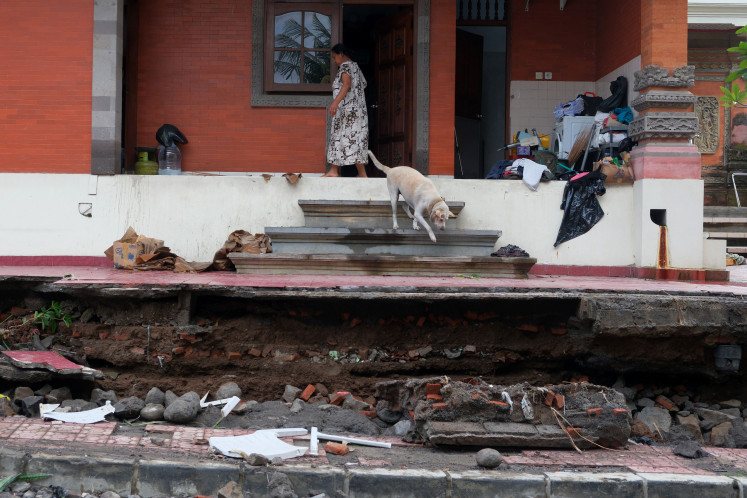Popular Reads
Top Results
Can't find what you're looking for?
View all search resultsPopular Reads
Top Results
Can't find what you're looking for?
View all search resultsSolo Bamboo Biennale, reviving bamboo's heyday
Opportunity: Opportunity: For bamboo workers with creative flair, there are opportunities to carve a piece of the creative-industries pie for themselves
Change text size
Gift Premium Articles
to Anyone
O
span class="caption">Opportunity: Opportunity: For bamboo workers with creative flair, there are opportunities to carve a piece of the creative-industries pie for themselves.
Indonesia is rich in bamboo varieties: 159 of the world's 1,250 bamboo species can be found in the archipelago, and 88 species are endemic.
Strong, durable and flexible, the plant used to provide the basic material for housing construction and for furnishings ranging from kitchen utensils to seats.
However, with changing times and technological advancements, bamboo's life-sustaining role has been sidelined.
There has been an erosion of bamboo culture and a shift to the use of other materials that are diversified, more practical, stronger and relatively cheaper that has been inevitable.
Yet bamboo has not been forgotten or abandoned.
In an attempt to revive bamboo culture, a month-long event, the Bamboo Biennale, will run at Vastenburg Fort in Surakarta, Central Java, until Sept. 28.
'This is the right time to revitalize bamboo culture, which was once deep-rooted in Indonesia,' Hari Waluyo, the director of media, design and technology-based creative economy for the Tourism and Creative Economy Ministry, said when opening the program in August.
Sixteen installations made from bamboo are on display, including works by Yu Sing from Akanoma Studio and Oky Kusprianto from Bandung, West Java; Yokosara, Gde Kreshna, and Effan Adiwira from Bali; and Budi Pradono, from Jakarta.
Paulus Mintaraga and Oky created the intriguing Sangkar Manu(k)sia (Human or bird cage), a three-meter-high cage-like tube with a diameter of about two meters. Inside is a round table and chair.
Okky and Paulus maintain that people miss the forest for the bamboo stalk, so to speak. 'If we look at a bird cage, we're thinking of what bird is inside ' while the cage is just forgotten,' they wrote in an artist's statement.
The pair intended for Sangkar Manu(k)sia to change perceptions of bamboo, so that people might perceive its beauty, strength and intensity.
Meanwhile, Budi's Tree House featured dozens of bamboo trays in the shape of a neat and artistic tree house, which users were allowed to scale.
Trays are a traditional means of winnowing rice grains made from woven bamboo sheets with cut bamboo stems forming round rims.
The artist collaborated with craftsmen from Simo, Central Java, to build the tree house, creating a triangular formation for the trays, which were staged more than five meters off the ground.
While bamboo might have a reputation as a second-class building material, it can be converted into artistic products of high quality and functionality, although it has been overshadowed by plastic, glass, steel and cement.
However, bamboo its advantages. It is fast growing, guaranteeing availability without an extended production process. Bamboo also has a unique rhizome-dependent root system enabling it to grow up to 60 centimeters.
However, for those bamboo workers with creative flair, there are opportunities to carve a piece of the creative industries pie for themselves. The local design industry accounts for Rp 25 trillion (US$2 billion) annually, employing 120,000 people; while architecture accounts for Rp12 trillion and 40,000 people.
Surakarta Mayor FX Hadi Rudyatmo is ready to support bamboo conservation, reserving land on the banks of the Solo River as a bamboo conservation zone and site for producers and artisan.
The city government wants the biennale to inspire local farmers and craftspeople, Hadi said.
'We want to encourage farmers to keep conserving bamboo and motivate the public to return to the use of bamboo, so that artists and craftspeople can maintain their creativity and bamboo will revive its heyday,' he said.











